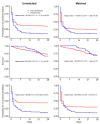Practice of Awake Prone Positioning in Critically Ill COVID-19 Patients-Insights from the PRoAcT-COVID Study
- PMID: 36498564
- PMCID: PMC9739110
- DOI: 10.3390/jcm11236988
Practice of Awake Prone Positioning in Critically Ill COVID-19 Patients-Insights from the PRoAcT-COVID Study
Abstract
We describe the incidence, practice and associations with outcomes of awake prone positioning in patients with acute hypoxemic respiratory failure due to coronavirus disease 2019 (COVID-19) in a national multicenter observational cohort study performed in 16 intensive care units in the Netherlands (PRoAcT−COVID-study). Patients were categorized in two groups, based on received treatment of awake prone positioning. The primary endpoint was practice of prone positioning. Secondary endpoint was ‘treatment failure’, a composite of intubation for invasive ventilation and death before day 28. We used propensity matching to control for observed confounding factors. In 546 patients, awake prone positioning was used in 88 (16.1%) patients. Prone positioning started within median 1 (0 to 2) days after ICU admission, sessions summed up to median 12.0 (8.4−14.5) hours for median 1.0 day. In the unmatched analysis (HR, 1.80 (1.41−2.31); p < 0.001), but not in the matched analysis (HR, 1.17 (0.87−1.59); p = 0.30), treatment failure occurred more often in patients that received prone positioning. The findings of this study are that awake prone positioning was used in one in six COVID-19 patients. Prone positioning started early, and sessions lasted long but were often discontinued because of need for intubation.
Keywords: COVID-19; acute hypoxemic respiratory failure; awake prone positioning; coronavirus disease 2019; outcome; prone positioning; propensity matching; self-proning.
Conflict of interest statement
The authors declare no conflict of interest. The funders had no role in the design of the study; in the collection, analyses, or interpretation of data; in the writing of the manuscript; or in the decision to publish the results.
Figures
References
-
- Esperatti M., Busico M., Fuentes N.A., Gallardo A., Osatnik J., Vitali A., Wasinger E.G., Olmos M., Quintana J., Saavedra S.N., et al. Impact of exposure time in awake prone positioning on clinical outcomes of patients with COVID-19-related acute respiratory failure treated with high-flow nasal oxygen: A multicenter cohort study. Crit. Care. 2022;26:16. doi: 10.1186/s13054-021-03881-2. - DOI - PMC - PubMed
Grants and funding
LinkOut - more resources
Full Text Sources



